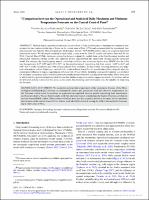Mostrar el registro sencillo del ítem
Comparison between the Operational and Statistical Daily Maximum and Minimum Temperature Forecasts in The Central Coast of Peru
| dc.contributor.author | Aliaga Nestares, Vannia | |
| dc.contributor.author | De la Cruz, Gustavo | |
| dc.contributor.author | Takahashi, Ken | |
| dc.date.accessioned | 2023-03-08T17:29:02Z | |
| dc.date.available | 2023-03-08T17:29:02Z | |
| dc.date.issued | 2023-02 | |
| dc.identifier.uri | https://hdl.handle.net/20.500.12542/2665 | |
| dc.description | https://github.com/gdelacruzm/TemperatureForecastLima | |
| dc.description.abstract | Multiple linear regression models were developed for 1-3-day lead forecasts of maximum and minimum temperature for two locations in the city of Lima, in the central coast of Peru (12°S), and contrasted with the operational forecasts issued by the National Meteorological and Hydrological Service - SENAMHI and the output of a regional numerical atmospheric model. We developed empirical models, fitted to data from the 2000-2013 period, and verified their skill for the 2014-2019 period. Since El Niño produces a strong low-frequency signal, the models focus on the high-frequency weather and subseasonal variability (60-day cutoff). The empirical models outperformed the operational forecasts and the numerical model. For instance, the high-frequency annual correlation coefficient and root mean square error (RMSE) for the 1-day lead forecasts were 0.37-0.53 and 0.74-1.76°C for the empirical model, respectively, but around −0.05-0.24 and 0.88-4.21°C in the operational case. Only three predictors were considered for the models, including persistence and large-scale atmospheric indices. Contrary to our belief, the model skill was lowest for the austral winter (June-August), when the extratropical influence is largest, suggesting an enhanced role of local effects. Including local specific humidity as a predictor for minimum temperature at the inland location substantially increased the skill and reduced its seasonality. There were cases in which both the operational and empirical forecast had similar strong errors and we suggest mesoscale circulations, such as the Low-Level Cyclonic Vortex over the ocean, as the culprit. Incorporating such information could be valuable for improving the forecasts. | es_PE |
| dc.format | application/pdf | es_PE |
| dc.language.iso | spa | es_PE |
| dc.publisher | American Meteorological Society | es_PE |
| dc.relation.uri | https://journals.ametsoc.org/view/journals/wefo/aop/WAF-D-21-0094.1/WAF-D-21-0094.1.xml | es_PE |
| dc.rights | info:eu-repo/semantics/openAccess | es_PE |
| dc.rights | Atribución-NoComercial-SinDerivadas 3.0 Estados Unidos de América | * |
| dc.rights.uri | http://creativecommons.org/licenses/by-nc-nd/3.0/us/ | * |
| dc.source | Repositorio Institucional - SENAMHI | es_PE |
| dc.source | Servicio Nacional de Meteorología e Hidrología del Perú | es_PE |
| dc.subject | Pronóstico Meteorológico | es_PE |
| dc.subject | Empirical Models | es_PE |
| dc.subject | Regression Models | es_PE |
| dc.subject | Temperatura del Aire | es_PE |
| dc.subject | Zona Costera | es_PE |
| dc.subject | Numerical Models | es_PE |
| dc.title | Comparison between the Operational and Statistical Daily Maximum and Minimum Temperature Forecasts in The Central Coast of Peru | es_PE |
| dc.type | info:eu-repo/semantics/article | es_PE |
| dc.identifier.doi | https://doi.org/10.1175/WAF-D-21-0094.1 | |
| dc.source.journal | Weather and Forecasting | |
| dc.subject.ocde | https://purl.org/pe-repo/ocde/ford#1.05.09 | es_PE |
| dc.subject.sinia | temperatura - Aire y Atmósfera | |
| dc.type.sinia | text/publicacion cientifica | |
| dc.identifier.url | https://hdl.handle.net/20.500.12542/2665 |
Ficheros en el ítem
Este ítem aparece en la(s) siguiente(s) colección(es)
-
Artículo científico [171]









